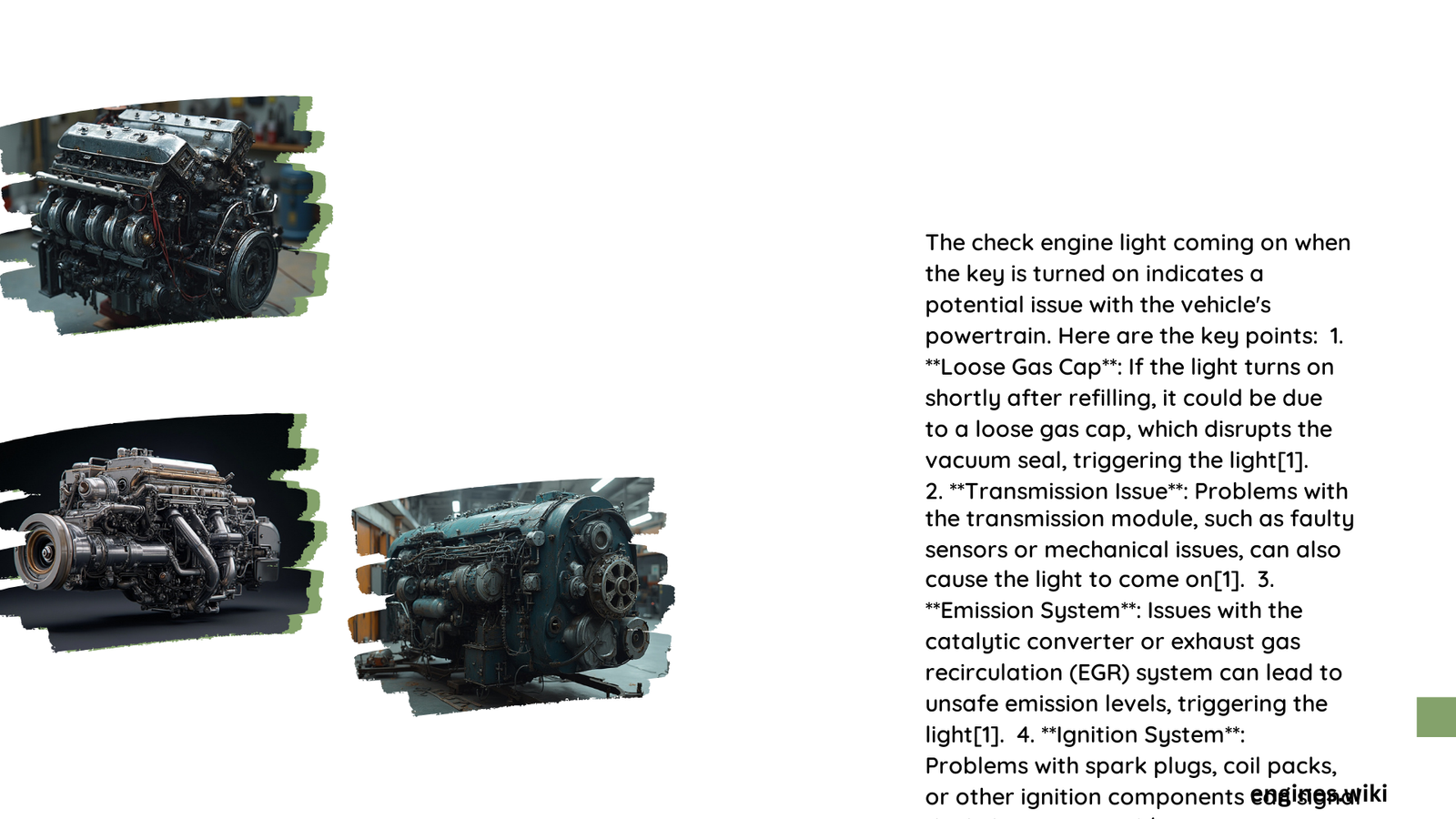When the check engine light illuminates as soon as you turn the key in the ignition, it indicates that your vehicle’s onboard diagnostic system has detected a problem. This issue can stem from various sources, ranging from minor concerns like a loose gas cap to more serious engine malfunctions. Understanding the potential causes and knowing how to address them can save you time, money, and prevent further damage to your vehicle.
Why Does the Check Engine Light Come On When Key Turned On?
The check engine light, also known as the Malfunction Indicator Lamp (MIL), is part of your vehicle’s onboard diagnostics system. When you turn the key in the ignition, the system performs a self-check. If it detects any issues during this process, the check engine light will illuminate. This immediate activation can be caused by:
- Persistent problems from previous driving cycles
- Malfunctioning sensors
- Issues with the engine control module
- Electrical system problems
What Are the Most Common Causes of Check Engine Light Activation at Ignition?

Several factors can trigger the check engine light when you turn the key:
-
Faulty Oxygen Sensor: This sensor measures the amount of unburned oxygen in the exhaust and helps regulate the fuel mixture. A malfunctioning sensor can cause the light to come on.
-
Loose or Faulty Gas Cap: A loose, damaged, or missing gas cap can trigger the check engine light due to fuel system pressure issues.
-
Catalytic Converter Problems: A failing catalytic converter can cause the light to illuminate as soon as the key is turned.
-
Mass Airflow Sensor Issues: This sensor measures the amount of air entering the engine. If it’s faulty, it can trigger the check engine light.
-
Battery or Charging System Problems: A weak battery or issues with the charging system can cause the light to come on at ignition.
How Can I Diagnose the Problem When the Check Engine Light Comes On at Key Turn?
To diagnose the issue, follow these steps:
- Use an OBD-II Scanner:
- Connect the scanner to the OBD-II port (usually under the dashboard)
- Turn the key to the “On” position without starting the engine
-
Read the diagnostic trouble codes (DTCs)
-
Check for Obvious Issues:
- Inspect the gas cap to ensure it’s tight and undamaged
-
Look for any loose wires or connections under the hood
-
Monitor Vehicle Performance:
-
Pay attention to any unusual sounds, smells, or performance issues
-
Consult the Vehicle’s Manual:
- Some vehicles have built-in diagnostic modes that can be accessed without a scanner
What Do Different Diagnostic Trouble Codes Mean?
Here’s a table of common DTCs and their meanings:
| Code Range | Potential Issue |
|---|---|
| P0001-P0099 | Fuel and air metering |
| P0100-P0199 | Fuel and air metering (injector circuit) |
| P0200-P0299 | Fuel and air metering (injector circuit) |
| P0300-P0399 | Ignition system or misfire |
| P0400-P0499 | Auxiliary emissions controls |
| P0500-P0599 | Vehicle speed controls and idle control system |
Can I Drive with the Check Engine Light On?
While it’s generally safe to drive short distances with the check engine light on, it’s not recommended for extended periods. Here’s why:
- The issue could worsen, leading to more expensive repairs
- Fuel efficiency may decrease
- Vehicle performance might be affected
- In some cases, it could be unsafe (e.g., if related to brakes or steering)
It’s best to have the problem diagnosed and addressed as soon as possible.
How Much Does It Cost to Fix a Check Engine Light Issue?
The cost to fix a check engine light issue varies widely depending on the underlying problem. Here’s a rough estimate for some common issues:
- Oxygen Sensor Replacement: $200 – $500
- Gas Cap Replacement: $20 – $50
- Catalytic Converter Replacement: $500 – $2,500
- Mass Airflow Sensor Replacement: $200 – $400
- Battery Replacement: $100 – $300
Labor costs can add significantly to these prices, typically ranging from $75 to $150 per hour.
What Preventive Measures Can I Take to Avoid Check Engine Light Issues?
To minimize the chances of the check engine light coming on when you turn the key, consider these preventive measures:
- Regular Maintenance: Follow your vehicle’s recommended maintenance schedule.
- Use Quality Parts: When replacing components, use high-quality, OEM or equivalent parts.
- Address Issues Promptly: Don’t ignore minor problems as they can lead to more significant issues.
- Keep the Battery in Good Condition: Regularly check and maintain your battery.
- Use the Right Fuel: Always use the recommended grade of fuel for your vehicle.
By understanding the causes and solutions for a check engine light that comes on when the key is turned, you can better maintain your vehicle and potentially save on costly repairs. Remember, while some issues can be diagnosed and fixed at home, it’s often best to consult with a professional mechanic for accurate diagnosis and repair.
References:
1. OBD-II Trouble Codes
2. Car Care Council – Check Engine Light
3. EPA – On-Board Diagnostics
